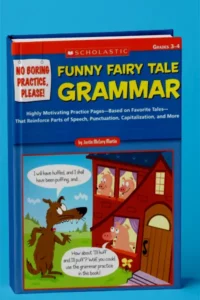Funny Fairy Tale Grammar: From subject-verb agreement to run-on sentences, these super-engaging reproducible pages give kids practice with key grammar skills.
Each activity offers a humorous twist on a folk or fairy tale to boost studentsinterest. Plus, they’ll enjoy a variety of formats, such as fill-in-the-blank stories, proofreading practice, crossword puzzles, and much more. Includes an answer key. For use with Grades.
It is a workbook with explanation. It will not make your kid a grammar ace or award winning writer, but he will have fun with this one (if he likes fairytales).
The best part was the learning extensions. These were silly writing prompts that encouraged DS to write his version of fairytales. He appreciated being able to use his imagination in his writing, and I appreciated someone else coming up with a writing topic for the day (sometimes that is the worst part.
Funny Fairy Tale Grammar
For kids, learning the rules of grammar can be a bit like eating green beans. They may know what’s good for them, but some dishes just aren’t any fun.
This book aims to remedy that situation. For example, the prospect of learning to differentiate common, comparative, and superlative adjectives may sound deadly dull to kids. But an exercise in this book called Fair, Fairer, and Fairest introduces this concept in a way that’s lighthearted and easy to understand.
This book covers topics that are key to honing writing skills: parts of speech, capitalization, plurals, commas, quotation marks, contractions, sentence fragments, homophones, and more. But the rules of grammar have been given what might be called a “fun-over.” Inside these pages you’ll find a variety of reproducible exercises involving crossword puzzles, letters, invitations, and even an activity called Pin the Preposition on the Ogre.
The exercises feature amusing takes on familiar fairy tale characters such as Cinderella, fairy tale mainstays such as castles and dragons, as well as fractured fare such as The Three Microscopic Pigs.
There are a huge number of grammar rules. Fortunately, there’s one rule that can stand just about anyone in good stead most of the time. It goes something like this: You know good grammar when you see good grammar.
That’s actually not a bad test. This book introduces students to the rules of grammar in a way that is memorable and easy to understand. Occasionally, terms such as predicate are used, but more often than not this book seeks to teach by example.
The aim is to spoon-feed the rules of grammar and make them go down easy. After students have finished this book, they may not remember the term superlative adjective. But hopefully they will have learned something far more important—namely, how to use adjectives properly.
So here’s wishing your students good grammar. The hope is that this book will make the subject so much fun that kids won’t even realize—until it’s too late—that they have learned some very useful rules to apply to their writing.


